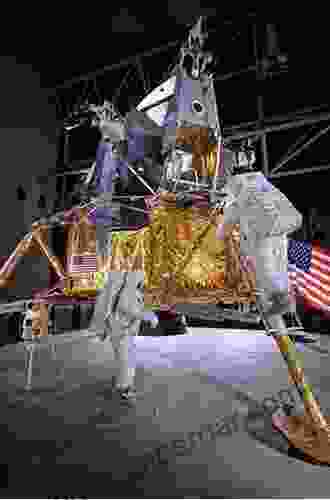Engineering America's First Moon Missions: A Triumph of Ingenuity and Perseverance

The journey to the Moon was one of the greatest scientific and engineering endeavors in human history. It was a race against time, a race against the Soviets, and a race to prove the superiority of American technology. The engineers who designed and built the rockets, spacecraft, and other equipment that made this journey possible were true pioneers, and their work is still studied and admired today.
In this article, we will take a closer look at some of the most significant engineering achievements of the Apollo program. We will explore the challenges that the engineers faced, the solutions they developed, and the impact that their work had on the world.
4.6 out of 5
| Language | : | English |
| File size | : | 9109 KB |
| Text-to-Speech | : | Enabled |
| Enhanced typesetting | : | Enabled |
| Word Wise | : | Enabled |
| Print length | : | 288 pages |
| Lending | : | Enabled |
| Screen Reader | : | Supported |
The Saturn V Rocket
The Saturn V rocket was the most powerful rocket ever built. It was capable of lifting over 280,000 pounds of payload into low Earth orbit, and it was the only rocket that was powerful enough to send humans to the Moon.
The Saturn V was a complex machine, consisting of three stages. The first stage was the S-IC, which was powered by five F-1 engines. The second stage was the S-II, which was powered by five J-2 engines. The third stage was the S-IVB, which was powered by a single J-2 engine.
The Saturn V was also a remarkably efficient rocket. It was able to achieve a specific impulse of 363 seconds, which was the highest specific impulse of any rocket ever built. This meant that the Saturn V could travel a long distance with a relatively small amount of fuel.
The Apollo Command Module
The Apollo command module was the spacecraft that carried the astronauts to the Moon and back. It was a small, cramped space, but it was packed with all of the systems that the astronauts needed to survive in space.
The command module was made up of three main sections: the command module, the service module, and the lunar module. The command module was where the astronauts lived and worked. The service module provided power, propulsion, and life support for the command module. The lunar module was used to land on the Moon.
The command module was a marvel of engineering. It was lightweight, strong, and reliable. It was also designed to be able to withstand the extreme temperatures and radiation of space.
The Apollo Lunar Module
The Apollo lunar module was the spacecraft that landed on the Moon. It was a small, fragile craft, but it was designed to withstand the harsh conditions of the lunar surface.
The lunar module consisted of two main stages: the descent stage and the ascent stage. The descent stage was used to land on the Moon. The ascent stage was used to lift off from the Moon and return to the command module.
The lunar module was a masterpiece of engineering. It was lightweight, strong, and reliable. It was also designed to be able to withstand the extreme temperatures and radiation of the lunar surface.
The Apollo Mission
The Apollo mission was a success. On July 20, 1969, Neil Armstrong and Buzz Aldrin became the first humans to walk on the Moon. The mission was a triumph of American engineering and perseverance.
The Apollo mission was not without its challenges. The engineers who designed and built the rockets, spacecraft, and other equipment that made this journey possible faced many obstacles. But they overcame these challenges with ingenuity and perseverance.
The Apollo mission is a testament to the power of human ingenuity. It is a reminder that anything is possible if we set our minds to it.
Impact of the Apollo Program
The Apollo program had a profound impact on the world. It inspired a generation of scientists and engineers. It also showed the world that anything is possible if we set our minds to it.
The Apollo program also had a significant impact on the economy. It created thousands of jobs and helped to spur the development of new technologies.
The Apollo program is a legacy that we can all be proud of. It is a reminder of what we can achieve when we work together.
The Apollo program was one of the greatest scientific and engineering endeavors in human history. It was a race against time, a race against the Soviets, and a race to prove the superiority of American technology. The engineers who designed and built the rockets, spacecraft, and other equipment that made this journey possible were true pioneers, and their work is still studied and admired today.
The Apollo program is a testament to the power of human ingenuity. It is a reminder that anything is possible if we set our minds to it.
4.6 out of 5
| Language | : | English |
| File size | : | 9109 KB |
| Text-to-Speech | : | Enabled |
| Enhanced typesetting | : | Enabled |
| Word Wise | : | Enabled |
| Print length | : | 288 pages |
| Lending | : | Enabled |
| Screen Reader | : | Supported |
Do you want to contribute by writing guest posts on this blog?
Please contact us and send us a resume of previous articles that you have written.
 Book
Book Novel
Novel Page
Page Chapter
Chapter Text
Text Story
Story Genre
Genre Reader
Reader Library
Library Paperback
Paperback E-book
E-book Magazine
Magazine Newspaper
Newspaper Paragraph
Paragraph Sentence
Sentence Bookmark
Bookmark Shelf
Shelf Glossary
Glossary Bibliography
Bibliography Foreword
Foreword Preface
Preface Synopsis
Synopsis Annotation
Annotation Footnote
Footnote Manuscript
Manuscript Scroll
Scroll Codex
Codex Tome
Tome Bestseller
Bestseller Classics
Classics Library card
Library card Narrative
Narrative Biography
Biography Autobiography
Autobiography Memoir
Memoir Reference
Reference Encyclopedia
Encyclopedia Joseph L Badaracco Jr
Joseph L Badaracco Jr Brendan Coyle
Brendan Coyle Brian Castner
Brian Castner C B Garris
C B Garris Edward Ellsberg
Edward Ellsberg Brian J Robinson
Brian J Robinson Jamie Fewery
Jamie Fewery Jo Carson
Jo Carson Bob Cashner
Bob Cashner Keith Robinson
Keith Robinson Kieran Setiya
Kieran Setiya Bruce Miller
Bruce Miller Jeri A Milstead
Jeri A Milstead Richard Lourie
Richard Lourie Jan Dommerholt
Jan Dommerholt David Cavan
David Cavan Bob Harris
Bob Harris Bonnie Henry
Bonnie Henry Clarice Wilsey
Clarice Wilsey Bruce Hood
Bruce Hood
Light bulbAdvertise smarter! Our strategic ad space ensures maximum exposure. Reserve your spot today!

 Jarrett BlairParallel Universes and the Deep Laws of the Cosmos: A Journey into the Unseen
Jarrett BlairParallel Universes and the Deep Laws of the Cosmos: A Journey into the Unseen Eddie BellFollow ·10.4k
Eddie BellFollow ·10.4k Edgar CoxFollow ·15.9k
Edgar CoxFollow ·15.9k Bryan GrayFollow ·8k
Bryan GrayFollow ·8k Howard BlairFollow ·16.3k
Howard BlairFollow ·16.3k Edward ReedFollow ·15.3k
Edward ReedFollow ·15.3k Floyd RichardsonFollow ·16.3k
Floyd RichardsonFollow ·16.3k Orson Scott CardFollow ·9.4k
Orson Scott CardFollow ·9.4k Zadie SmithFollow ·17.1k
Zadie SmithFollow ·17.1k

 Gary Cox
Gary CoxUnlocking Meaning and Purpose in Life: An Exploration of...
In an increasingly...

 Eric Hayes
Eric HayesMemoirs of the Early Pioneer Settlers of Ohio Illustrated
A Window into the Lives of Courageous...

 J.R.R. Tolkien
J.R.R. TolkienThe Montgomerys and Their Descendants: A Saga of Courage,...
Prepare to be...

 Avery Simmons
Avery SimmonsThe Rifle Musket: The Dawn of Modern Infantry Warfare
: The rifle musket, a revolutionary...

 Jesse Bell
Jesse BellUnlock the Power of Excel with VBA and Macros: A...
Microsoft Excel is a powerful spreadsheet...
4.6 out of 5
| Language | : | English |
| File size | : | 9109 KB |
| Text-to-Speech | : | Enabled |
| Enhanced typesetting | : | Enabled |
| Word Wise | : | Enabled |
| Print length | : | 288 pages |
| Lending | : | Enabled |
| Screen Reader | : | Supported |












